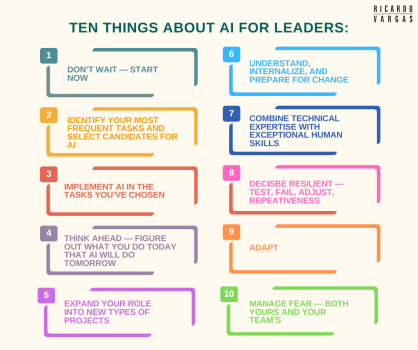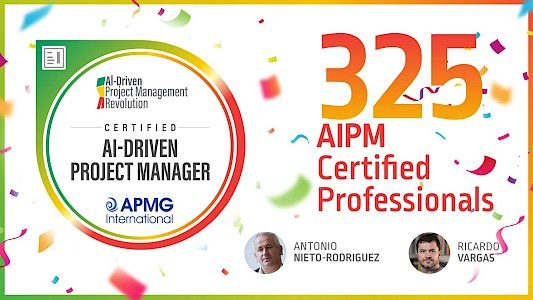Issue #19 - This Is What You’re Not Seeing About AI
Hey everyone!
I’m back with a brand-new edition of our newsletter—and this one goes deep.
This month, we’re peeling back the curtain on AI. Not just the flashy tools and viral demos, but the invisible transformation happening beneath the surface.
We’ll explore why we keep overestimating AI’s short-term power and missing its long-term potential, dive into the ethics of algorithmic life-or-death decisions, and unpack what a $500B data center says about our future with AGI.
We also celebrate crossing 325+ AIPM certifications (thank you!) and launch a new video on AWP that could reshape your project planning game.
If you’re leading AI projects—or trying to make sense of the hype—this issue is for you.
Let’s stay curious, stay grounded, and build what matters.
Happy reading!
Ricardo

In This Issue
- Why Do We Overestimate AI's Impact in the Short-Term and Underestimate It in The Long-Term?
- Would You Let an Algorithm Decide Who Lives or Dies?
- AI Could Get 1,000,000x Smarter in Just 4 Years (Yes, You Read That Right)
- $109 Billion Went Into AI Last Year. But... Where Are the Results?
- We've Just Hit 325+ AIPM Certified Professionals!
- New Long-Format Video Released on my YouTube Channel: AWP Secrets - The Fast Track to Project Wins
Why Do We Overestimate AI's Impact in the Short-Term and Underestimate It in The Long-Term
AI is either moving too fast or not fast enough, depending on who you ask.
And today, it's hard not to be amazed. Everywhere you look, there's a new AI tool promising to revolutionize your productivity, help you write faster, think clearly, and create better.
Whether it's ChatGPT drafting your next email, Midjourney generating images in seconds, or a new Chrome extension claiming to optimize your entire day, AI is everywhere.
And it feels like we're on the edge of something massive.
But there's a paradox here.
Because while we're mesmerized by AI's current capabilities, we may be completely unprepared for what's coming next.
We overestimate its immediate impact — we think it's going to change everything overnight —and at the same time, we drastically underestimate its long-term implications.
This isn't a new pattern.
Roy Amara, a futurist from the Institute for the Future, captured it perfectly:
"We tend to overestimate the effect of a technology in the short run and underestimate the effect in the long run."
The quote above is called Amara's Law. And it's precisely what we're living through right now.
We are obsessed with the visible and the now. The demos. The interface. The productivity spike.
And, to be fair, there is something genuinely impressive about what AI tools can already do.
In many industries, AI is helping accelerate processes that were previously manual or time-consuming. It's doing customer support, transcribing meetings, generating code, and even creating original content.
At the recent SXSW event, I saw firsthand how excited people are. The air was thick with "Did you see this?" energy. People weren't just talking about AI—they were actively building businesses around it.
The vibe was: This is it. This is the future.
I even recorded a video on my YouTube channel about the five main quotes I took away from this event:
But if we're honest, most of the value created so far is still surface-level.
What we're seeing is the tip of a much deeper iceberg. The part we interact with—natural language chat, image generation, voice tools—is incredible, but it's also just the beginning.
Behind all that, there's a far more complex reality: models still hallucinate, understanding nuance is still a challenge, bias is more and more present, and real-world integration is complex, especially at scale.
AI isn't "here to replace us" — YET.
Most people still use these tools casually, inconsistently, and often without a real sense of what's happening under the hood. They're like people driving a high-performance vehicle without knowing how the engine works or how fast it can really go.
And despite all this buzz, we haven't seen the kind of systemic transformation that matches the size of the investment.
In 2024 alone, over $109 billion was invested in AI, according to the Stanford AI Index Report. One hundred and nine billion.
That's not a bet on productivity in the next quarter. That's a bet on an entirely different world in the future. But ask yourself: have we seen a $109B leap in how society works? How business is done? In how we live?
It reminds me of the gold rush. The ones who got rich weren't always the miners—they were the ones selling the tools.
In today's AI gold rush, it's the OpenAIs and NVIDIAs of the world who are making the real money. The rest of us? We're still learning how to pan for gold.
This gets more interesting when you look at where AI is really going. Most people aren't paying attention to the infrastructure side of things. But that's where the transformation is quietly happening.
Take the Stargate Project, for instance—a $500B initiative to build the world's most powerful AI data center. Five hundred billion dollars.
Why? Because the models of the future will require massive compute power. We're talking energy infrastructure, specialized chips, distributed training clusters, and terabytes of real-time data.
The groundwork for AGI — Artificial General Intelligence — isn't being laid in public demos. It's being poured into the concrete of data centers and silicon factories.
While the public often associates progress in AI with eye-catching product launches, viral chatbot interactions, or impressive live demonstrations, these are merely the visible outputs — not the foundation.
The real work is happening behind closed doors, deep in the infrastructure that supports AI at scale.
It's in the design and deployment of massive computational clusters, the engineering of advanced chips optimized for machine learning, and the steady expansion of data pipelines that feed these models with the information they need to learn.
AGI won’t emerge from a stage performance — it will emerge from years of investment in hardware, research, and systems capable of supporting intelligence at a planetary scale.
It's happening where most people aren't looking.
And that's the heart of this paradox. What really changes is that everything won't come with a flashy launch video. It won't have a marketing rollout.
It'll be slow, almost invisible — until one day it's just there.
Like the internet. Like electricity. Like roads. AI will disappear into the infrastructure of daily life. It'll become boring. Essential. Inescapable.
We're already seeing this in areas that most people don’t consider exciting—logistics, procurement, medical imaging, insurance underwriting. These are the industries where AI is quietly redefining the rules.
Not with fireworks, but with steady, compounding change. With models that know your supply chain better than you do. That diagnoses illnesses before you feel sick. They run entire back offices autonomously.
These shifts won't be dramatic. They'll be structural.
That’s why I’m concerned about the current conversation around AI. We’re prioritizing what’s new over what’s lasting—focusing on today’s hype rather than what will truly matter to us and to society in the long run.
And nowhere is this more evident than in project management. Because here's the uncomfortable truth:
Most people managing AI projects today are planning for a short-term win, not long-term resilience.
Most of us are optimizing for speed, not adaptability. We are chasing quick adoption without building institutional learning.
This is dangerous because the role of the project manager is about to change dramatically.
As AI starts to take over monitoring, estimating, scheduling, and even risk analysis, what's left?
What do we do?
We lead. We synthesize. We guide.
But only if we adapt.
The skill set of the future PM isn't just technical—it's strategic. We won't survive on process knowledge alone. We'll need critical thinking, emotional intelligence, and the ability to work alongside machines as partners, not tools.
I learned this in part from a place you wouldn't expect — Burning Man.
Out there in the chaos, the sand, the madness, you see what happens when plans fall apart and people have to build systems from scratch.
It's raw, it's weird, but it teaches you how to see differently. That kind of environment forces creativity.
It kills rigid thinking.
And right now, that's exactly the mindset leaders need to cultivate. Because AI won't follow your Gantt chart, it won't respect your timeline. It'll evolve, surprise, and destabilize everything unless you're willing to move with it.
So, how do we prepare?
I've been talking a lot about this lately, especially in conferences.
At the Brazilian Congress of Project Management, I shared a framework—ten things I believe every leader needs to keep in mind when it comes to AI:
- Don't wait — start now.
- Identify your most frequent tasks and select candidates for AI.
- Implement AI in the tasks you've chosen.
- Think ahead — figure out what you do today that AI will do tomorrow.
- Expand your role into new types of projects.
- Understand, internalize, and prepare for change.
- Combine technical expertise with exceptional human skills.
- Be resilient — test, fail, adjust, repeat.
- Adapt.
- Manage fear — both yours and your team's

Figure 1 — AI "Thinking" Framework
AI isn't just a tool. It's a turning point.
This is the shift we're living through. From fascination to integration. From tool use to societal redesign. And in the middle of it, we have a choice:
To be reactive, or to be ready.
You're not wrong to be excited about AI. But don't mistake sparks for fire.
The fundamental transformation isn't what's happening now. It's what's coming next.
Stay amazed—but stay alert.
What Has Been on My Radar Recently?
Would You Let an Algorithm Decide Who Lives or Dies?
Here's something wild I've been exploring lately — and you should too.
The Moral Machine is a project from MIT, UBC, and the Max Planck Institute that puts you in the driver's seat — literally.
Through interactive tests, it challenges you to make split-second ethical decisions for autonomous vehicles in life-or-death scenarios.
It's not just a thought experiment.
These are the exact kinds of decisions machines will need to make in the real world, and your choices are contributing to a global dataset shaping future AI ethics.
Want a quick breakdown of what this all means? Watch this short video — it's 6 minutes of pure perspective shift:
If you're in tech, management, or just a curious human, this one will stay with you. Seriously. Try the tests.
AI Could Get 1,000,000x Smarter in Just 4 Years (Yes, You Read That Right)
One stat has been living rent-free in my head lately.
David Sacks, Chief AI Officer for the U.S., just shared a bold prediction: AI performance could increase by a million times by 2028. Not 2x. Not 10x. A million.
It's not just about processing speed or model size — it's about how everything (hardware, algorithms, data, scale) is compounding at once.
This has massive implications for all of us.
If you're building, managing, or using AI in any form, buckle up.
The next few years won't be incremental... they'll be exponential.
$109 Billion Went Into AI Last Year. But... Where Are the Results?
We've officially hit triple-digit billions in AI investment.
According to the latest Stanford AI Index Report (2025) that I mentioned previously in this newsletter, over $109 billion was poured into AI in 2024 alone.
But here's the thing despite all the headlines and hype, the actual productivity gains remain minimal.
It feels a bit like a gold rush — with tech giants selling the picks and shovels, while the rest of us are still figuring out where to dig.
This report is the most comprehensive overview of where AI is actually working, and where it's still spinning its wheels.
I talked about this in my latest episode of the 5 minutes podcast, here:
Quick Announcements
We've Just Hit 325+ AIPM Certified Professionals!
Antonio Nieto-Rodriguez and I have some amazing news to share:
In early May, we hit a brand new milestone. Over 325 professionals are now officially AIPM-Certified through our partnership with APMG International! Since then, we have had 13 new certificates in the first half of May. We are now extremely excited to partner with ATOs globally to deliver it in countries like the UK, China, and the Middle East!
This certification isn't just a badge — it's a game-changer for project managers looking to embed AI into their practice, make better decisions, and lead to more innovative projects in an increasingly complex world.

To celebrate, we launched a limited-time promotion:
Use code DISRUPTION to get Prep Materials + Exam for $399 USD (usually $499 USD).
Learn more and sign up here: pmairevolution.com/certification
A huge thank you to everyone who's already joined us on this journey. Your belief in AIPM continues to inspire us daily
New Long-Format Video Released on My YouTube Channel: AWP Secrets - The Fast Track to Project Wins
"AWP Secrets: The Fast Track to Project Wins" is now live on YouTube and LinkedIn. This time, I walk through Advanced Work Packaging (AWP) step by step, showing how the method helps teams anticipate risks, align scope, schedule resources, and turn complex plans into concrete results.
Even if AWP is new to you, the video offers practical tactics you can apply right away to shorten timelines and control costs.
I cannot mention the video without thanking the colleagues who supported the production behind the scenes. You are amazing!
Finally, I hope you find the content valuable. You will find the link to the video below:
Your Voice Matters!
You can also read the previous issues here.
If you have any suggestions, comments, or anything else that will help me make it better, please send a note to [email protected]
Please feel free to share this newsletter with your friends, colleagues, and other people you may find will benefit from it.
They can also subscribe to receive it here.
Thanks for your support, and I hope it was helpful to you.
Cheers,
Ricardo Vargas



